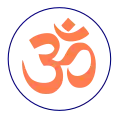| Part of a series on |
| Hinduism |
|---|
 |
In Hindu culture, a Pravara (Sanskrit for "most excellent") is a system of identity, particularly a family line.[1] Pravaras is a particular Brahmin's descent from a rishi (sage) who belonged to their gotra (clan).[2]
Significance
The Pravara has been extensively used in identifying one's ancestry and thus giving salutations to the listener. In Vedic ritual, the importance of the pravara appears to be in its use by the ritualist for extolling his ancestry and proclaiming, "as a descendant of worthy ancestors, I am a fit and proper person to do the act I am performing." Generally, there are three, five or seven pravaras. The sacred thread yajnopavita worn on upanayana has close and essential connection with the concept of pravaras related to Brahmin gotra system. While tying the knots of sacred thread, an oath is taken in the name of each one of these three, five or seven of the most excellent rishis belonging to one's gotra.
The full affiliation consists of (1) Gotra, (2) Sutra (of Kalpa), (3) Shakha, (4) Pravaras .
For instance, a Brahmana named 'Rama' may introduce himself as follows: I am 'Rama', of Sarvarna gotra, of Gobhil sutra, of Taittiriya shākha of the Samveda, of five pravaras named Bhārgava, Chyāvana, Āpnavan, Aurva, and Jāmdagnya (This example is based upon the example given by Pattābhirām Shastri in the introduction to Vedārtha-Pārijata, cf. ref.)
While the gotras were classified initially according to seven rishis, the pravaras were classified under the names of the following seven rishis: Agastya, Angirasa, Atri, Bhrigu (Bhargava), Kashyapa, Vashista, and Vishvamitra.
According to the listing of authors included in the verses in Rigved, the rishi Jamadagni was a descendant of rishi Bhrigu while the rishis Gautama and Bharadvaja were the descendants of rishi Angirasa.
The pravara identifies the association of a person with two, three (or sometimes five) of the above-mentioned rishis. It also signifies the Sutras contributed to different Vedas by those rishis.
Pravaras also help in identifying different gotras bearing the same name. For e.g.: Harita Gotra with Pravaras Angirasa, Ambarisha, Yuvanashva is different from Harita Gotra which has a single Pravara Vashishta.
Gotra Pravara
- Vasistha:
- Vasistha, Saktya, Parāsara
- Kauṇḍinya, Maitravaruṇa, Vasiṣṭha
- Kapisa: Angiras, Bharadwaja, Bārhaspatya, Vandana, Matavacha
- Kundina Gautama: Angiras, Āyāsya, Kuṇḍina Gautama
- Bharadwāja: Aṅgiras, Bārhaspatya, Bharadwāja
- Shaunaka: Bhārgava, Saunahotra, Gritsamada
- Vadula: Bhārgava, Vaitahavya, Sāvedasa
- Srivatsa and Vatsa: Bhārgava, Chyavana, Apnavān/Apnuvat, Aurava, Jāmadagnya (Paraśhurāma)
- Sāvarṇa: Aurava, Chyavana, Bhārgava, Jamadagni, Apnuvat
- ĀAtreya: Atreya, Archanās, Syavasva
- Kauśika: Vaiśvāmitra, Agamarṣaṇa, Kausika
- Kalabodhana/Kalabaudha: Visvamitra, Āgamarṣaṇa, Kālabodhana/Kālabaudha
- Bhārgava: Bhārgava, Tvaṣṭā, Viśvarūpa
- Visvāmitra:
- Vaisvāmitra, Devarāta, Autala
- Vaisvāmitra, Ashtaka
- Kauṇḍinya: Vāsiṣṭha, Maitravāruṇa, Kauṇḍinya
- Kapinjala: Vasiṣṭha, Aindrapramada, Abharadvāsavya
- Harita/Haritasa:
- Gautamas: Angiras, Āyāsya, Gautama
- Maudgalya: (3 Variations)
- Angiras, Bharmyasva, Maudgalya
- Tarkṣya, Bharmyasva, Maudgalya
- Angiras, Dhavya, Maudgalya
- Sandilya: (2 Variations)
- Naidhruvakasyapa: Kasyapa, Avatsara, Naidhruva
- Kutsa: Angirasa, Mandhātā, Kautsa
- Kapila: Angirasa, Amahaiya, Orukṣaya
- Kanva: (2 Variations)
- Parasara: Vasiṣtha, Saktya, Parasarya
- Upamanyu: Aindrapramada, Bhadravasavya
- Āgastya: Agastya, Tardhachyuta, Saumavaha
- Gārgi: (2 Variations)
- Angirasa, Bharhaspatya, Bharadwaja, Sainya, Gargya
- Angirasa, Sainya, Gargya
- Bādarāyaṇa: Angirasa, Parsadaśva, Ratitara
- Kasyapa: (3 Variations)
- Sankṛti: (2 Variations)
- Suryadhwaja: Lakhi Maharṣi, Sorala, Binju
- Daivaratasa: Visvamitra, Daivaratasa, Avudhala
- Pauragutsa: Vidahavya, Travedasa, Tradadasyuhu
- Ratitaras: Angirasa, Vairupya, Parshadas'va
- Mauna Bhargavasa: Bhargava, Vitahavya, Savedasa
Example
Example transliteration of a pravara
चतुस्सगारा पर्यन्तं गो ब्रह्मणेभ्यः शुभम भवतु अन्गिरस भारद्वाज गार्ग्य शैन्य त्रयारिशयोः प्रवरांविता गार्ग्य भारद्वाज गोत्रः आपस्तम्ब सूत्रः यजुह शाखाधायी श्रीराम शर्मः अहम् भो अभिवादये॥
Example (Bharadvajasya Gotram):
Chathusagara paryantham go-brahmane-bhyaha shubham bhavathu Aangirasa, Bharaspatya, Bharadwajasya Triyarusheya pravaranvita Bharadvajasya grotraha apastamba sutrah yajush(Yajurveda) Saakhadhayi (Your Name) Sharma aham bho abhivadhaye:
Explanation of the example
Line 1: Prologue: May the world be blessed from all the cows and Brahmanas across the four seas
Line 2: The names and number of the main rishis to whose lineage the person belongs
Line 3: Gotra of the person
Line 4: The sutra that the person follows
Line 5: The veda shakha that the person belongs to
Line 6: Name of the person followed by 'SHARMA'
Line 7: Aham bho abhivadhaye meaning greetings/salutations
See also
References
- ↑ Narain, Dhirendra; Sociology, University of Bombay Department of; Research, Indian Council of Social Science (1989). Research in Sociology: Abstracts of M.A. and Ph. D. Dissertations Completed in the Department of Sociology, University of Bombay. Concept Publishing Company. p. 226. ISBN 978-81-7022-235-4.
- ↑ Ghurye, Govind Sadashiv (1972). Two Brahmanical Institutions: Gotra and Charana. Popular Prakashan. p. 13.
